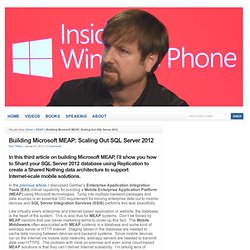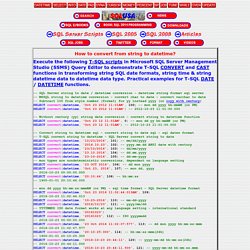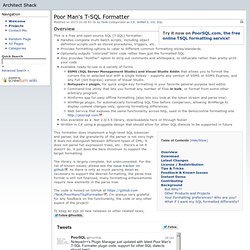

Building Microsoft MEAP: Scaling Out SQL Server. In the previous article, I discussed Gartner’s Enterprise Application Integration Tools (EAI) critical capability for building a Mobile Enterprise Application Platform (MEAP) using Microsoft technologies.

Tying into multiple backend packages and data sources is an essential CIO requirement for moving enterprise data out to mobile devices and SQL Server Integration Services (SSIS) performs this task beautifully. Like virtually every enterprise and Internet based application or website, the database is the heart of the system. This is also true for MEAP systems. Don’t be fooled by MEAP vendors that use clever marketing terms to cover up this fact. The Mobile Middleware often associated with MEAP systems is a database and some kind of web/app server or HTTP listener. When it comes to boosting performance and supporting more concurrent clients, you think of scaling up with beefier hardware and scaling out with more servers. Obviously, this only takes you so far before you run out of gas.
SQL Datetime Conversion - String Date Convert Formats - SQLUSA. Execute the following T-SQL scripts in Microsoft SQL Server Management Studio (SSMS) Query Editor to demonstrate T-SQL CONVERT and CAST functions in transforming string SQL date formats, string time & string datetime data to datetime data type.

Practical examples for T-SQL DATE / DATETIME functions. -- SQL Server string to date / datetime conversion - datetime string format sql server -- MSSQL string to datetime conversion - convert char to date - convert varchar to date -- Subtract 100 from style number (format) for yy instead yyyy (or ccyy with century) SELECT convert(datetime, 'Oct 23 2012 11:01AM', 100) -- mon dd yyyy hh:mmAM (or PM) SELECT convert(datetime, 'Oct 23 2012 11:01AM') -- 2012-10-23 11:01:00.000. Arrays and Lists in SQL Server 2008. An SQL text by Erland Sommarskog, SQL Server MVP.

Latest revision: 2012-07-01. Introduction In the public forums for SQL Server, you often see people asking How do I use arrays in SQL Server? Or Why does SELECT * FROM tbl WHERE col IN (@list) not work? The short answer to the first question is that SQL Server does not have arrays – SQL Server has tables. This changed with SQL 2008. The examples are in C# and VB .NET, using the SqlClient API, and the main body of the article covers this environment. There is an accompanying article: Arrays and Lists in SQL Server 2005 and Beyond (and an even older for SQL 2000) where I in detail describe various methods to pass a list of values in a string and unpack them into a table in SQL Server.
Contents: Background You have a number of key values, identifying a couple of rows in a table, and you want to retrieve these rows. List is here a string variable that you somewhere have assigned a comma-separated list, for instance "9,12,27,39". ... Declarations. Poor Man's T-SQL Formatter - Architect Shack. The library is largely complete, but undocumented.

For the list of known issues, please see the issue tracker on github. As there is only as much parsing detail as necessary to support the desired formatting, the parse tree format is still not finalized; many formatting enhancements require new elements in the parse tree. The code is hosted on GitHub at I'm always very grateful for any feedback on the functionality, the code or any other aspect of the project! To keep an eye on new releases or other related news, I also send out occasional announcement emails to people who've contacted me - email me at tao@klerks.biz if you'd like to get these announcements (this might eventually become a real mailing list). Ready-to-run: SSMS and Visual Studio Add-In (setup program): SqlFormatterSSMSAddIn.Setup.1.5.3.msi (11302 downloads for this version, about 30000 for previous versions). Or if you just want to show your support, you can report your use of the project on Ohloh: But Why??